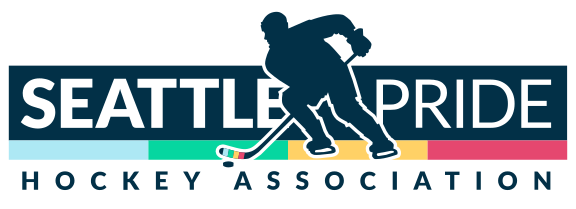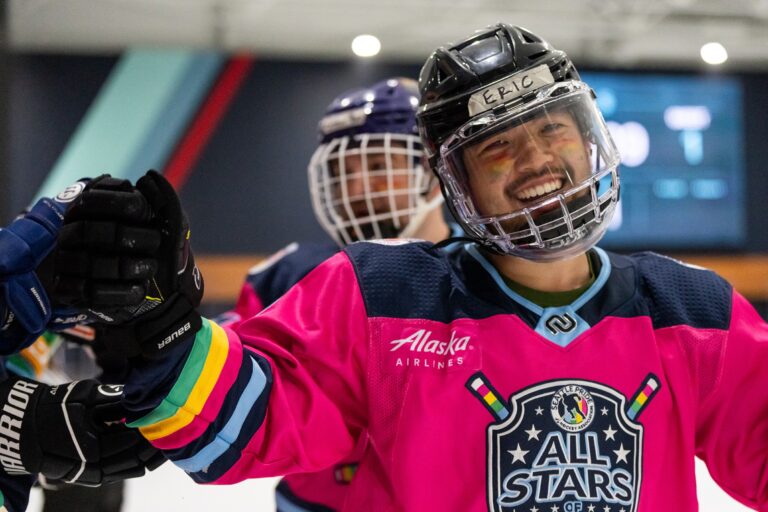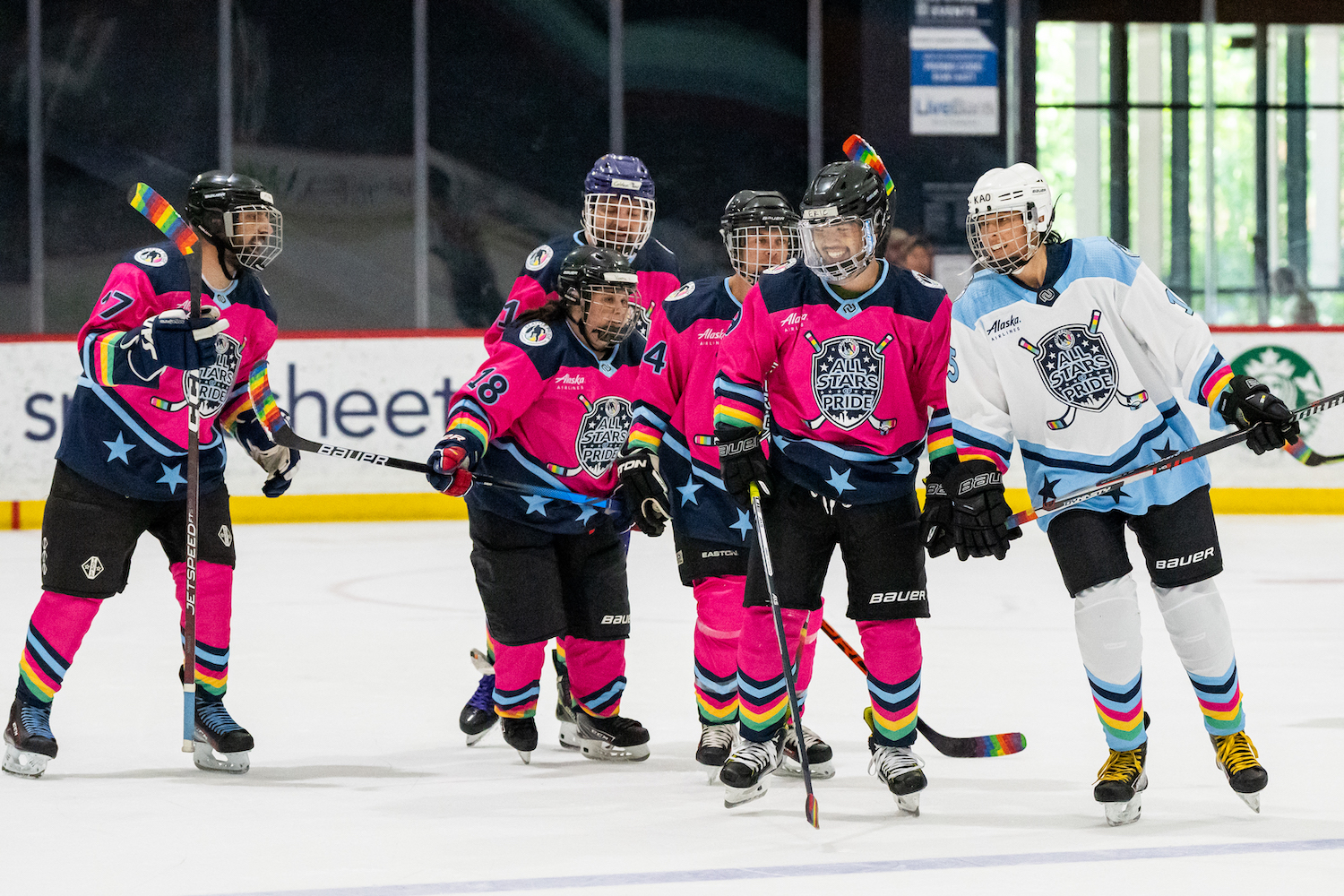NEW TO HOCKEY?
If you are new to hockey and interested in picking up the sport, it may seem overwhelming all of the things you have to accomplish. Between learning how to skate, acquiring equipment/gear (also commonly called a ‘kit’), joining a learn to play, then long at last, finding a team to join, there’s a lot of steps. We are providing these great resources to hopefully ease the process for you.
It is important to keep in mind that safety and comfort are critical to ensuring players have fun. We encourage players to wear all necessary protective gear on the ice. That includes a helmet with full face cage/shield, shoulder pads, elbow pads, shin guards, gloves, hockey pants, and jocks.
Here is a preview of the most common pieces of equipment and their primary purpose:
Moisture-wicking undergarments – Provides warmth and protection from the gear itself while wicking away sweat during play.
Jock/Jill – Typically these include a one piece short with built-in cup and Velcro tabs at thighs to hold up ice hockey socks.
Shin Pads – Should cover the knee and shin completely to protect from collisions, sticks, and pucks.
Hockey Socks – Part of the team uniform and should match the team colors; held in place with fastener or Velcro tabs on jock short; pulled over and covers the shin guards.
Hockey Pants – Protection for lower spine/tailbone, hips, and thighs. The length should come to the top of shin pads.
Skates – Skates are an essential piece of equipment to play ice hockey, and periodic sharpenings are necessary for the skater’s success.
Shoulder Pads – These are designed to protect the chest, shoulder, and top of arms.
Elbow Pads – These are designed to protect the elbow from hard falls or collisions as well as protecting the forearms from sticks and pucks.
Hockey Jersey – Typically provided by the team as part of the uniform. Jerseys should be tried on with shoulder pads to determine the appropriate fit. Generally, sleeves will come just below wrists to the top of hand and length will cover to thighs.
Helmet with face mask – The head is the most important part of the body, and the helmet is designed to reduce the chance of skull fractures. No helmet prevents concussions, but they can reduce the risk depending on padding and design. The face mask minimizes facial injury from sticks or flying pucks.
Gloves – Protects hands, fingers, and wrists.
Stick – A straight wood stick is a good starter stick for first-time players. As players become more experienced, they can begin to make decisions on the curve, lie and the use of composite sticks. Length of the stick should generally extend from the ice/floor to the player’s chin with skates on – an inch or two more of length is okay to allow for growth. Equipment experts can provide recommendations for each player and will cut the stick to the proper size
Hockey is a high-speed game played on ice with the object being to shoot a small rubber puck into the opposing team’s net, scoring a goal for your team.
Players and Positions
Full ice hockey games are played with six players from each team on the ice. Each team has one goaltender, two defensemen and three forwards. The players are allowed to change with their teammates on the bench during play or stoppages of play following a whistle.

Centerman: is the player that takes the faceoffs. Centers are a key position as they often have more defensive responsibilities than the wings but are also expected to produce offensively by scoring goals or setting up their teammates.
Winger: flank the center on faceoffs. While they have defensive assignments in their own zone, these two forwards often have a slightly more offensive mindset than centers. Despite their titles, the wingers are not always confined to one side of the ice.
Defensemen: usually are set up behind the forwards. The defensemen’s main objective is preventing the opposition from scoring and assisting the forwards in getting the puck out of the defensive zone. They can also contribute on the offensive side but usually don’t play as deep in the offensive zone.
Goaltender: main objective is to prevent the opponent from scoring.
Three Zones of Play
The defensive zone is the area between the goal which your team is defending and the first blue line. This is the zone that your team tries to prevent the opponent from scoring in.
The neutral zone is the area between the two blue lines.
The offensive zone is the area between the second blue line and the opposing team’s net. This is the zone in which your team is trying to score.
During the second period, teams will switch the sides of the ice that they are defending. Therefore, the zone that was initially their defensive zone becomes their offensive zone and vice versa. The teams return to their initial nets and zones for the third period.
Here is an overview of the most common rules and infractions seen in hockey. For a more in-depth look, check out the USA Hockey Official Rules of Ice Hockey.
Face-Offs:
This is the method by which the puck is put into play. During a face-off, one player from each team lines up to face each other at one of the rink’s nine face-off spots. The referee or linesman drops the puck between the players, who then battle for possession.
Offsides:
This occurs when a player enters the offensive zone before the puck. It results in a stoppage of play and neutral zone faceoff.

Icing:
When a defending player sends the puck, untouched, from behind the center red line across the opposing team’s goal line in the offensive zone. This results in a stoppage of play and a faceoff in the offending team’s defensive zone.
Hand Pass:
Players in hockey are not allowed to play the puck with their hand outside of their defensive zone. When a player moves the puck to a teammate with his hand, the official blows the whistle, and there is a faceoff at the position where the puck was passed from. At no time can players close their hand on the puck.
High Stick:
When the puck is played out of mid-air by a player whose stick is above shoulder height and a teammate is the next to touch the puck, a high stick infraction is called, resulting in a face-off in that team’s defensive zone.
Minor Penalties:
Players can be assessed penalties for improper conduct on the ice. The most common penalties are minor penalties, in which players must sit in the penalty box for two minutes, or until the other team scores, while their team plays shorthanded.
Here are the most common minor penalties:
Tripping: Player uses a stick, arm, or leg to take an opponent’s feet out from under them.
High-Sticking: Striking an opponent with the stick above shoulder level.
Slashing: The act of swinging a player’s stick at an opponent, whether contact is made or not.
Holding: Player holds an opponent by using his hands, arms, or legs.
Interference: Player interferes with or impedes the progress of an opponent who is not in possession of the puck.
Elbowing: Involves the use of an extended elbow to perform an illegal body check.
Cross-Checking: A check made with the stick while both hands are on the stick and arms extending to deliver the hit.
Hooking: Using the stick in a manner that enables a player to restrain an opponent, typically through a pulling motion.
Boarding: Checking an opponent in such a manner that causes the opponent to be thrown violently into the boards.
Roughing: Involves the use of unnecessary roughness during play or between whistles.
Major Penalties:
Major penalties are assessed for many of the same infractions that apply to minor penalties except they involve a greater degree of deliberate violence that can result in injury. The player who is serving the five-minute major must stay in the penalty box for the full five minute penalty time, regardless if a goal is scored on the “shorthanded” team.
Assist: An assist is credited to a player who helps set up a goal. Assists are awarded to the last two offensive players to handle the puck before a goal, including those who shoot the puck on net.
Backchecking: Forwards in the attacking zone skate back to their end to prevent opponent’s shots on goal.
Breakaway: A clear scoring opportunity where no defensive player is between the puck carrier and the goaltender.
Box: A defensive system (similar to the diamond) often used by teams on the penalty kill.
Breakout: The play used by the attacking team to move the puck out of its own zone and up the ice toward the opponent’s goal.
Bucket: Slang term for a helmet.
Crease: Blue semi-circle in front of the goal. Goaltenders receive special privileges and protection while in this area.
Cherry Picking: When a player, generally a forward, hangs out by the red line while the play is in his/her team’s defensive zone. The player is waiting for an outlet pass so that he can have a breakaway.
Changing on the Fly: When players from the bench substitute for players on the ice while the clock is running.
Coast to Coast: Refers to when a player carries the puck from deep in his own defensive zone, all the way to the opposing team’s goal.
Crashing the Net: A strategy in which a forward heads toward the opponent’s net in hopes of deflecting a shot, banging a loose puck in, obstructing the goaltender’s view, or simply creating mayhem that could lead to a scoring chance for his team.
Dangling: When a player uses great stickhandling moves to skate through the opposing team while maintaining possession of the puck.
Deke: A fake by a player in possession of the puck to get around an opponent or to make a goalie move out of position.
Dump and Chase: A style of hockey where a team shoots the puck into one of the corners of the offensive zone and then pursues it.
Empty Netter: A goal scored against an opponent that has pulled the goalie for an extra attacker in an attempt to tie the game. This typically happens late in the third period with under two minutes to play in the game.
Five-Hole: The hole between the goalie’s leg pads. If a player scores a goal and the puck went in between the goalie’s pads, the puck went through the five-hole.
Forecheck: The way a team’s forwards put pressure on the opposing team while in the offensive zone to keep the puck or take it away from the opposition.
Freezing the Puck: A goalie freezes the puck (when the opposition is threatening to score) by either holding the puck in the glove or trapping it on the ice.
Garbage Goal: A goal that takes little talent to score. Most such goals are scored from right in front of the net, often when the goaltender is out of position.
Hat Trick: A player who scores three goals in one game achieves a “hat trick.”
One-timer: Shooting the puck immediately upon receiving it without stopping it first.
Penalty Kill: When a team is shorthanded (only four players on the ice) due to a penalty and attempts to prevent the opposition from scoring.
Penalty Shot: A free shot, unopposed except for the goalie, most commonly award to players that have full possession with no opposing player between them and the goalie but are taken down by the opposition. The team which commits the offense is not penalized beyond the penalty shot, whether it succeeds or not.
Power Play: Happens when a team has a one- or two-man advantage over the opposition due to penalties.
Rink: The ice on which the game of hockey is played. Rinks are typically 200-feet long by 85-feet wide. This is also referred to as an NHL-sized rink. Olympic rinks are 200-feet long by 100-feet wide.
Save: When a goalie prevents a shot from going into the net.
Screen: Occurs when one or more players are between the shooter and the goalie, shielding the goalie’s view of the play and incoming shot.
Shorthanded: Happens to your team when the opposing team has a one- or two-man advantage due to penalties.
Slap Shot: A slap shot occurs when the player swings the stick back and then quickly forward, slapping the puck ahead with a forehand shot.
Snap Shot: An abbreviated slap shot that occurs without the stick leaving the ice. The purpose of the snap shot is to combine the main advantages of the wrist shot (shot accuracy and quick delivery) and the slap shot (puck speed).
Stick-handling: A term for carrying the puck along the ice with the stick.
Turnover: Losing control of the puck to the opposing team.
Wrist Shot: Players roll their wrists quickly and powerfully to generate a shot. Typically, the most common and accurate type of shot.
Zamboni: The vehicle used to prepare the rink’s ice surface before the game and during intermissions. The Zamboni scrapes a thin layer off the ice while also putting down a fresh layer of heated water that freezes to form a new layer of ice.
Please check out the videos below to see how to properly dress / suit up as a skater or goaltender.
Skaters:
Goaltenders:
Need TO BUY EQUIPMENT?
Below is an exhaustive list of many of the items you will need to outfit yourself with. Our partners at Breakaway Hockey Company — located inside Olympicview Arena — are your go-to resource to acquire everything you need.




